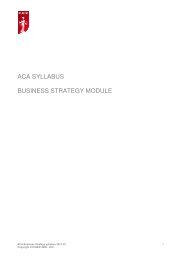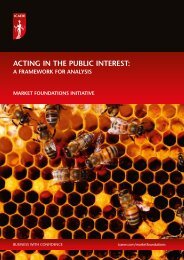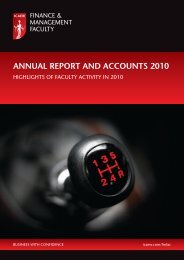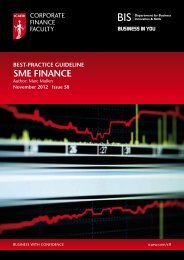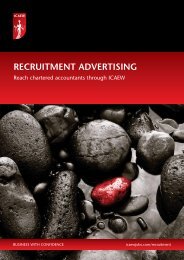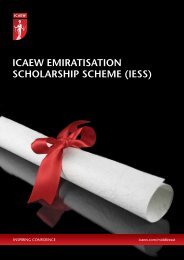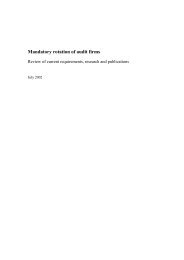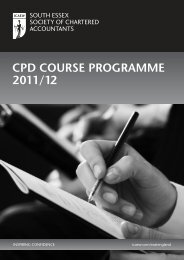Auditor independence and non-audit services - ICAEW
Auditor independence and non-audit services - ICAEW
Auditor independence and non-audit services - ICAEW
Create successful ePaper yourself
Turn your PDF publications into a flip-book with our unique Google optimized e-Paper software.
CHAPTER 7IMPACT OF JOINT PROVISION AND JOINT PROVISION DISCLOSURESON AUDITOR INDEPENDENCE PERCEPTIONS AND DECISIONS:SURVEY AND EXPERIMENTAL STUDIES7.1 IntroductionThere exists a large body of empirical evidence concerning the impact of variouseconomic <strong>and</strong> regulatory factors on the perception of <strong>audit</strong>or <strong>independence</strong>. This is fortwo reasons. First, actual <strong>audit</strong>or <strong>independence</strong> is extremely difficult to observe, <strong>and</strong> sothe focus of research effort has been on perceptions. Second, perceptions are ofimportance in their own right. One of the key variables investigated in such studies isjoint NAS provision. Research design issues are discussed in section 7.2, while thefindings from such studies (grouped by country) are presented in section 7.3.However, a significant number of studies examine the behaviour or decisions associatedwith these perceptions (in some cases in addition to an investigation of <strong>audit</strong>or<strong>independence</strong> perceptions). For example, bank loan officers are asked whether (<strong>and</strong> onwhat terms) they would grant loans to the client company. In a few cases, the decisionsof <strong>audit</strong>ors (rather than users) are investigated <strong>and</strong> this research design is a way ofassessing actual <strong>audit</strong>or <strong>independence</strong>. This group of studies is reviewed in section 7.4.Empirical studies have generally involved mail surveys, either questionnaires or selfadministeredexperiments.There are two opposing views regarding the impact of joint NAS provision on <strong>audit</strong>or<strong>independence</strong>. The first (arguably more common) view is that the economic bond(economic dependence) is increased <strong>and</strong> the relationship becomes too close, adverselyimpacting <strong>audit</strong>or <strong>independence</strong>. The alternative view is that the <strong>audit</strong>or’s knowledgeof the client company is enhanced, <strong>and</strong> that such knowledge spillovers increaseobjectivity <strong>and</strong> <strong>independence</strong> (Goldman <strong>and</strong> Barlev, 1974; Wallman 1996).A much smaller body of studies explore the impact of NAS disclosures about theprovision of NAS on perceptions of <strong>audit</strong>or <strong>independence</strong>. These appear in section7.5.7.2 Research design issuesMost studies either focus exclusively on actual or proposed ethical rules or investigate avery limited number of key generic threat factors (such as <strong>audit</strong> fee dependence;competition within the <strong>audit</strong> market; the joint provision of NAS; <strong>and</strong> the degree of laxityof the regulatory framework). In the former case, the questionnaires present a list offactors to be assessed individually. In the latter case, a limited number of factors arecombined in ‘case studies’ with a repeated-measures, fixed effects experimentaldesign 11 , allowing investigation of interaction effects. The underlying model being testedhas a measure of <strong>audit</strong>or <strong>independence</strong> perceptions as the dependent variable <strong>and</strong> the11 In this experimental design, subjects are repeatedly asked about the same factors, each set at severaldifferent levels. A repeated measures design is also called a ‘within-subjects’ design, to be contrastedwith a ‘between-subjects’ design. The lack of repetition in the latter is desirable to reduce thepossibility of ‘dem<strong>and</strong> effects’, where the subjects guess the purpose of the study <strong>and</strong> respond as theythink the researcher wants. Unfortunately, a between-subjects design requires the participation of manymore subjects.34




